Click here to see ISW’s interactive map of the Russian invasion of Ukraine. This map is updated daily alongside the static maps present in this report.
Click here to access ISW’s archive of interactive time-lapse maps of the Russian invasion of Ukraine. These maps complement the static control-of-terrain map that ISW produces daily by showing a dynamic frontline. ISW will update this time-lapse map archive monthly.
Note: The data cutoff for this product was 12:30pm ET on June 22. ISW will cover subsequent reports in the June 23 Russian Offensive Campaign Assessment.
Ukrainian forces continued counteroffensive operations in at least three sectors of the front and reportedly made gains on June 22. The Ukrainian General Staff reported that Ukrainian forces conducted offensive operations in the Kreminna area in Luhansk Oblast, in western Zaporizhia Oblast, and on the administrative border between Zaporizhia and Donetsk oblasts.[i] Ukrainian Deputy Defense Minister Hanna Malyar reported that Ukrainian forces in the Kreminna area achieved partial successes and consolidated themselves in new positions.[ii] Ukrainian Tavrisk Group of Forces Spokesperson Captain Valeriy Shershen reported that Ukrainian forces advanced up to one kilometer in western Zaporizhia Oblast and on the administrative border between Zaporizhia and Donetsk oblasts.[iii] Shershen added that these Ukrainian advances were tactical measures aimed at improving Ukrainian positions along the front.[iv] The Russian Ministry of Defense (MoD) claimed that Ukrainian forces also conducted unsuccessful offensive operations along the Avdiivka-onetsk City front.[v] Ukrainian Prime Minister Denys Shmyhal stated on June 21 that Ukrainian forces have liberated eight settlements and over 113 square kilometers of territory since starting counteroffensive operations on June 4.[vi]
Senior Kremlin officials continue to publicly address the Ukrainian counteroffensive in a cohesive manner and acknowledge Ukrainian forces will conduct further operations, while continuing to inflate Russian successes. Russian Defense Minister Sergei Shoigu claimed at a Russian Security Council meeting on June 22 that Ukrainian forces are regrouping and restaffing to prepare for further offensive operations in a single unspecified direction after “suffering significant losses.”[vii] Shoigu claimed that both Russian and Ukrainian forces are preparing for further offensive operations. Security Council Secretary Nikolai Patrushev claimed that Russian forces destroyed a heavily exaggerated amount of Ukrainian military equipment, including Western-provided equipment. Wagner Group financier Yevgeny Prigozhin claimed that his reporting on Ukrainian gains differs from official reports because Shoigu and Chief of the Russian General Staff Valery Gerasimov lie and exaggerate.[viii] Prigozhin claimed on June 13 that Ukrainian forces have likely liberated over 100 square kilometers since the start of the counteroffensive, in stark contrast to the Russian MoD’s continual denial of Ukrainian territorial gains.[ix]
Russian Defense Minister Sergei Shoigu announced that the Russian Ministry of Defense (MoD) will form a “reserve army” by the end of June, form a new army corps, and reinforce key Western Military District (WMD) formations as part of intended force restructuring. Shoigu told Russian President Vladimir Putin that Russia is forming reserves for an unnamed army corps and an unspecified “reserve army” and adding five regiments to the 1st Guard Tank Army and the 20th Guards Combined Arms Army — both part of the WMD.[x] Shoigu noted that the five regiments are already 60 percent staffed and equipped as of June 22. Shoigu’s announcement likely confirms ISW’s previous reports that the Russian military command is forming the 25th Combined Arms Army with recruits from the Russian Far East and is establishing the 40th Army Corps as part of the Southern Military District (SMD).[xi] The 20th Combined Arms Army is based on the northeast Ukrainian border and the 1st Guards Tank Army was (prior to February 2022) Russia’s highest quality army, making these formations the logical first recipients of new regiments. Shoigu previously outlined Russian efforts to conduct large-scale military reforms between 2023 and 2026 to optimize Russian Armed Forces for large-scale conventional warfare and expand Russian conventional forces on January 17, though as ISW assessed at the time Russia will struggle to fully staff and equip these large formations using existing force-generation processes.[xii]
The Russian MoD likely seeks to mitigate this force-generation challenge at least in part with volunteer formations.[xiii] Shoigu claimed that Russia recruited 114,000 servicemen for contract service and 52,000 volunteers — noting that 1,336 people sign contracts with the Russian MoD each day and that Russia can form a regiment every 24 hours. This statement is not to be taken literally though since Russian regiments typically contain over 2,000 personnel.[xiv] Shoigu added that Russia is not committing volunteers because “there is no urgent need” to deploy these forces to the battlefield. ISW previously observed residents of the Russian Far East receiving messages inviting men to join the 25th Combined Arms Army, indicating that the Russian MoD seeks to directly recruit volunteers to staff its formations.[xv] Shoigu also ordered Russian volunteer formations on June 10 to sign military contracts with the Russian MoD by July 1, which will also formally provide additional forces to the Russian MoD for its large-scale military reforms.[xvi] Russia’s previous attempt to form a volunteer-based 3rd Army Corps in summer of 2022 did not establish a combat-effective force, however.[xvii]
The Russian MoD is unlikely to fully formalize Russian volunteer formations by its stated July 1 deadline. The Russian MoD claimed on June 22 that four additional volunteer formations signed contracts with the MoD and that more than 20 volunteer formations have done so since the MoD began the effort to have all volunteers sign contracts.[xviii] The MoD previously claimed on June 10 that more than 40 volunteer formations are currently active.[xix] The MoD may nominally have all volunteer formations sign contracts before July 1, but the extent of actual command ties is unclear. ISW previously assessed that the MoD’s formalization efforts intend to centralize control over Russian irregular personnel and supplies to respond to Ukraine’s counteroffensive as well as restrict the influence of figures outside of the MoD.[xx] It is unclear why a significant portion of volunteer formations have yet to sign contracts with the MoD, although Prigozhin’s criticism that MoD subordination could adversely impact command and control within irregular formations may be reflective of widespread concerns among these irregular Russian forces.[xxi] The signing of contracts is the first phase of formalizing volunteer formations, and it is unclear if the MoD will be able to quickly, or at all, establish practical and effective control once these formations are de jure subordinated to the MoD, and the scale of implementation will vary between units.
Ukrainian President Volodymyr Zelensky stated that Ukrainian intelligence indicates that Russian forces are preparing to conduct a possible sabotage attack at the Zaporizhzhia Nuclear Power Plant (ZNPP). A Russian-created radiological incident at the ZNPP remains unlikely but not impossible. Zelensky stated that the planned attack would release radiation from the ZNPP, and announced that Ukrainian officials will widely share their intelligence on the planned attack with partners and international organizations in the coming days.[xxii] Ukrainian Main Military Intelligence Directorate (GUR) Head Kyrylo Budanov reported on June 20 that Russian forces had mined additional areas at the ZNPP, including the facility’s cooling pond.[xxiii] The International Atomic Energy Agency (IAEA) stated on June 21 that its representatives have not observed any mines at the cooling pond, although it did acknowledge that Russian forces have mined areas in and around the ZNPP.[xxiv] Russian forces would not be able to control the consequences of an intentional radiological incident at the ZNPP, which could impact their forces more than Ukrainian forces across the Kakhovka Reservoir given conditions at the time of the incident. An intentional radiological incident could also leave many areas in occupied southern Ukraine uninhabitable and ungovernable, further degrading Russia’s ability to cement its occupation of southern Ukraine, and the destruction of the power plant would be a drastic act. Russian forces may be signaling that they are preparing to sabotage the ZNPP in order to dissuade Ukrainian forces from conducting counteroffensive operations in the area. The Kremlin has routinely employed threats of nuclear escalation and warned of (largely Russian imposed) threats to the safety of the ZNPP in an attempt to pressure Ukraine to constrain its military actions and prevent further Western security assistance to Ukraine.[xxv] However, the destruction of the Nova Kakhovka dam also harmed Russian forces, and possible Russian plans to sabotage the ZNPP cannot be ruled out and should be prepared for by Ukraine and its partners.
Ukrainian forces may be intensifying efforts to strike Russian ground lines of communication (GLOCs) in southern Ukraine. Ukrainian Melitopol Mayor Ivan Fedorov reported on explosions in Melitopol and Yakymivka in Zaporizhia Oblast and Chonhar in Crimea on June 22.[xxvi] Russian sources claimed that Ukrainian forces conducted a Storm Shadow strike on the Chonhar Bridge, along the E105 highway connecting Russian-occupied Kherson Oblast and Crimea.[xxvii] Some Russian sources claimed that Ukrainian forces also struck a bridge across Lake Syvash.[xxviii] Ukrainian forces may be intensifying their efforts to strike rear areas and vulnerable areas along GLOCs to disrupt Russian supply routes.[xxix] Widespread Russian milblogger outrage and concern about the strike could indicate that Russian forces may be increasingly concerned over their ability to secure GLOCs in southern Ukraine.[xxx]
Ukrainian President Volodymyr Zelensky acknowledged that Western partners have different expectations for Ukraine’s counteroffensive and stated that Ukrainian forces will perform operations as Ukraine sees fit independent of pressure from another country.[xxxi] CNN reported on June 22 that senior US and other Western officials stated the Ukrainian counteroffensive thus far has failed to live up to expectations, but the officials acknowledged that the counteroffensive is still in the early phases and Western states remain hopeful that Ukrainian forces will make significant gains.[xxxii] ISW continues to assesses that the slow pace of current Ukrainian counteroffensive operations is not emblematic of Ukrainian forces’ overall offensive potential and that Ukrainian forces are likely setting conditions for a future main counteroffensive effort which will take time to conduct.[xxxiii]
Key Takeaways
- Ukrainian forces continued counteroffensive operations in at least three sectors of the front and reportedly made gains on June 22.
- Senior Kremlin officials continue to publicly address the Ukrainian counteroffensive in a cohesive manner and acknowledge Ukrainian forces will conduct further operations, while continuing to inflate Russian successes.
- Russian Defense Minister Sergei Shoigu announced that the Russian Ministry of Defense (MoD) will form a “reserve army” by the end of June, form a new army corps, and reinforce key Western Military District (WMD) formations as part of intended force restructuring.
- The Russian MoD is unlikely to fully formalize Russian volunteer formations by its stated July 1 deadline.
- Ukrainian President Volodymyr Zelensky stated that Ukrainian intelligence indicates that Russian forces are preparing to conduct a possible sabotage attack at the Zaporizhzhia Nuclear Power Plant (ZNPP). A Russian-created radiological incident at the ZNPP remains unlikely but not impossible.
- Ukrainian forces may be intensifying efforts to strike Russian ground lines of communication (GLOCs) in southern Ukraine.
- Ukrainian President Volodymyr Zelensky acknowledged that Western partners have different expectations for Ukraine’s counteroffensive and stated that Ukrainian forces will perform operations as Ukraine sees fit independent of pressure from another country.
- Russian and Ukrainian forces continued ground attacks near the Kupyansk-Svatove line.
- Ukrainian forces continued counteroffensive operations near Kreminna.
- Russian forces conducted limited ground attacks near Bakhmut.
- Russian and Ukrainian forces conducted limited ground attacks along the Avdiivka-Donetsk City line.
- Ukrainian and Russian forces continued offensive operations on the administrative border between Donetsk and Zaporizhia oblasts.
- Ukrainian forces continued counteroffensive operations in western Zaporizhia Oblast.
- Ukrainian officials reported that Russian forces are transferring GRU Spetsnaz units to Kursk and Bryansk oblasts to fight Russian partisans.
- Russian sources claimed that the Russian Federal Security Service (FSB) arrested a group of saboteurs in occupied Melitopol that allegedly planned the assassination of unnamed Zaporizhia Oblast occupation officials and sabotage against railroads.
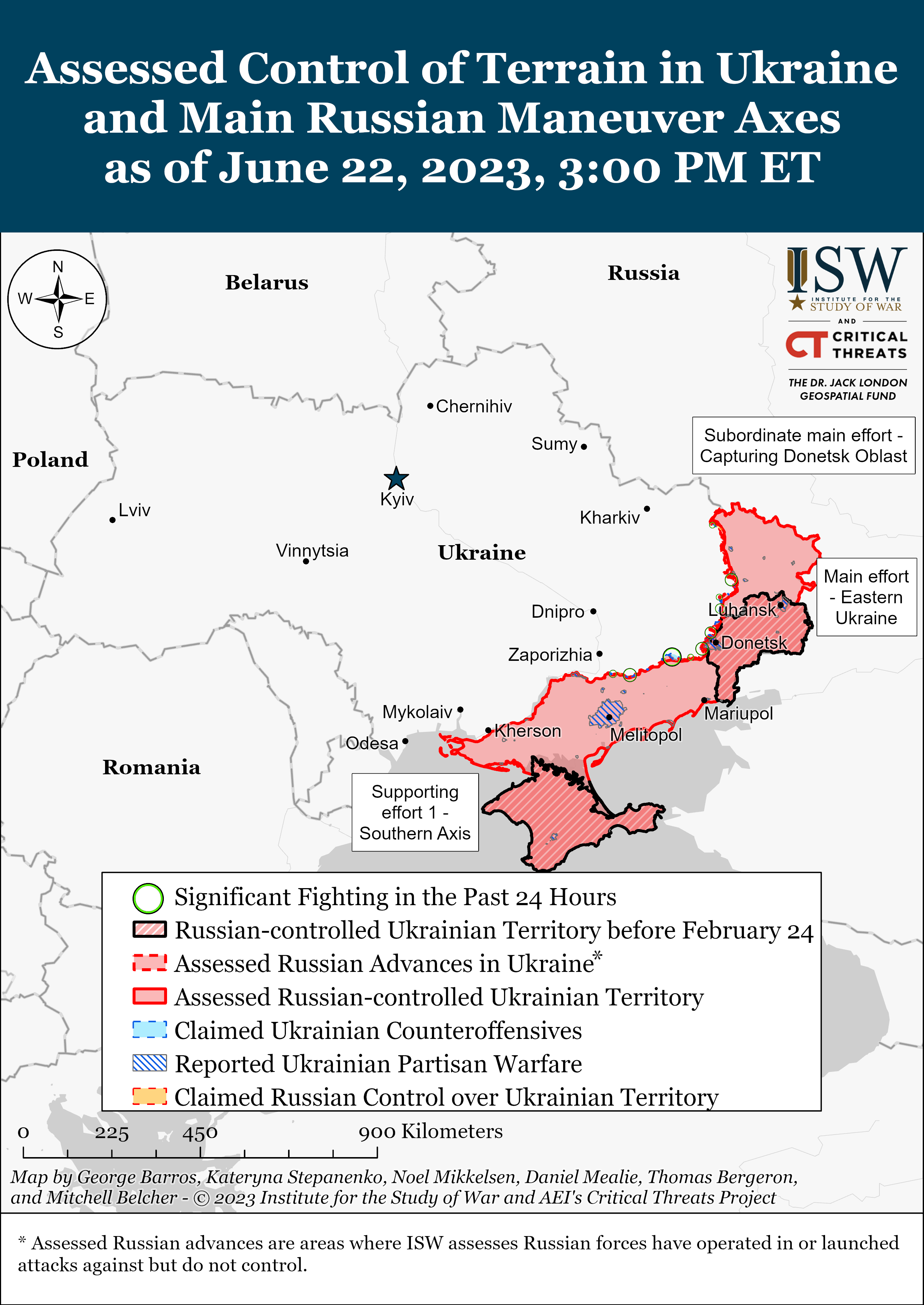
We do not report in detail on Russian war crimes because these activities are well-covered in Western media and do not directly affect the military operations we are assessing and forecasting. We will continue to evaluate and report on the effects of these criminal activities on the Ukrainian military and the Ukrainian population and specifically on combat in Ukrainian urban areas. We utterly condemn these Russian violations of the laws of armed conflict, Geneva Conventions, and humanity even though we do not describe them in these reports.
- Russian Main Effort – Eastern Ukraine (comprised of two subordinate main efforts)
- Russian Subordinate Main Effort #1 – Capture the remainder of Luhansk Oblast and push westward into eastern Kharkiv Oblast and encircle northern Donetsk Oblast
- Russian Subordinate Main Effort #2 – Capture the entirety of Donetsk Oblast
- Russian Supporting Effort – Southern Axis
- Russian Mobilization and Force Generation Efforts
- Activities in Russian-occupied areas
Russian Main Effort – Eastern Ukraine
Russian Subordinate Main Effort #1 – Luhansk Oblast (Russian objective: Capture the remainder of Luhansk Oblast and push westward into eastern Kharkiv Oblast and northern Donetsk Oblast)
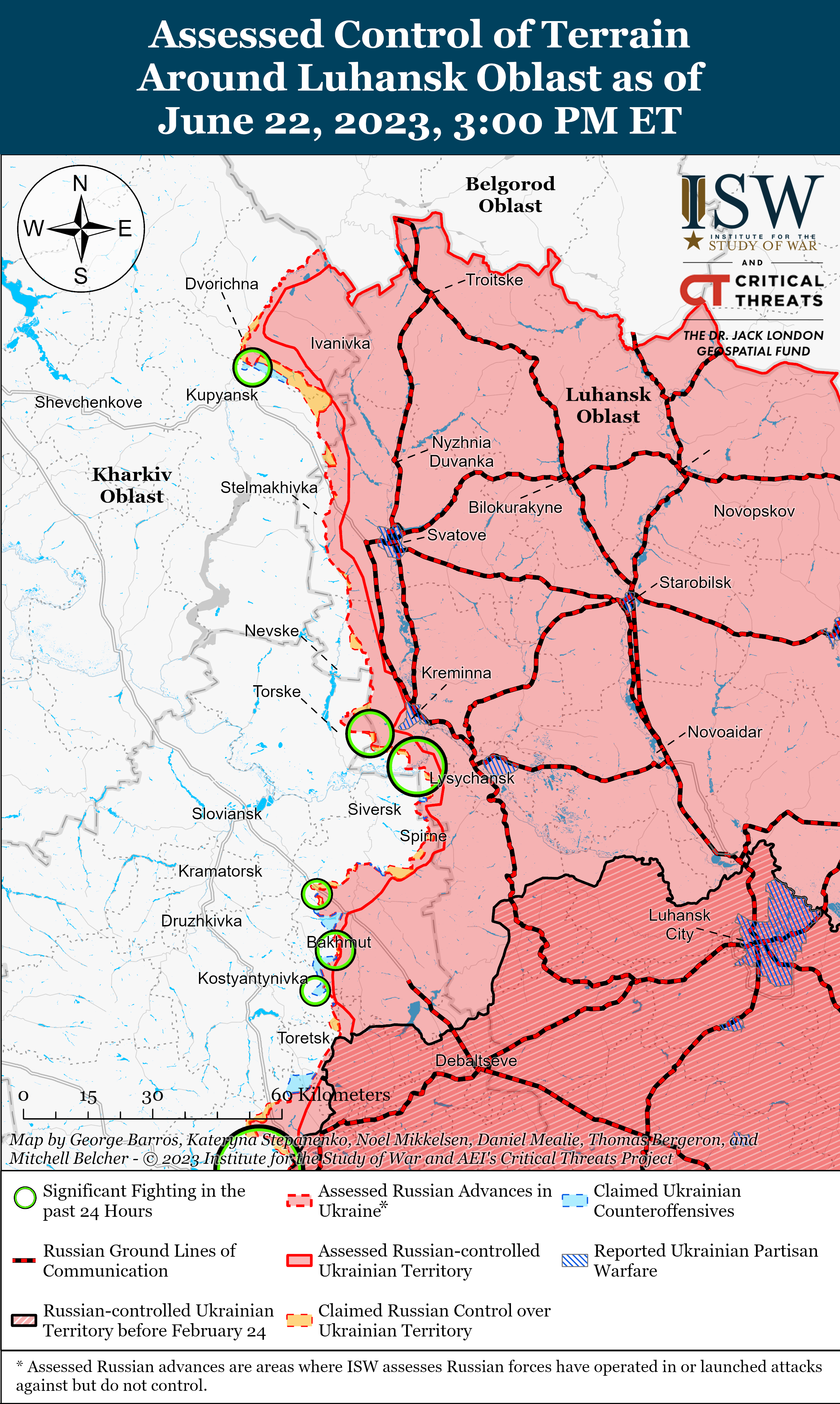
Russian and Ukrainian forces continued ground attacks on the Kupyansk-Svatove line on June 22. The Ukrainian General Staff reported that Russian forces conducted unsuccessful offensive operations near Synkivka (8km northeast of Kupyansk).[xxxiv] The Russian Ministry of Defense (MoD) claimed that Russian forces repelled two Ukranian sabotage and reconnaissance groups operating near Synkivka and Novoselivske (16km northwest of Svatove).[xxxv] A Russian milblogger claimed that Russian forces continue to attack in the Kupyansk direction and are clearing forest areas as they advance toward Holubivka (5km north of Kupyansk) and Synkivka .[xxxvi]
Ukrainian forces continued counteroffensive operations near Kreminna on June 22. The Ukrainian General Staff reported that Ukrainian forces conducted offensive operations in the Bilohorivka-Dibrova direction (within 10km south of Kreminna), achieved partial success, and consolidated new lines.[xxxvii] Ukrainian military officials reported heavy fighting northwest of Dibrova (7km southwest of Kreminna), near the Serebrianske forest area (11km south of Kreminna), and north of Hryhorivka (10km south of Kreminna).[xxxviii] The Russian Ministry of Defense (MoD) claimed that Russia‘s “Center” Group of Forces repelled five Ukrainian attacks near Kuzmyne (3km southwest of Kreminna) and in the Serebrianske forest area.[xxxix] The Russian MoD also claimed that Russian forces stopped three Ukrainian sabotage and reconnaissance groups near Yampolivka (17km west of Kreminna), Dibrova, and in the Serebrianske forest.[xl] A Russian milblogger claimed that Ukrainian forces are continuing to launch counteroffensive operations despite unsuccessful attacks in the past three days.[xli] A Kremlin-affiliated milblogger claimed Ukrainian forces attempted and failed to advance from Bilohorivka (12km south of Kreminna) to Shypylivka (9km south of Kreminna).[xlii] The milblogger also claimed that Russian forces pushed Ukrainian forces back into the Serebrianske forest area southeast of Kuzmyne and claimed that fierce battles continue near Yampolivka.[xliii]
Russian forces continued to counterattack Ukrainian positions near Kreminna amidst ongoing Ukrainian counteroffensives. The Ukrainian General Staff reported that Russian forces conducted unsuccessful offensive operations near Dibrova, Bilohorivka, and Serebrianka.[xliv] Russian milbloggers claimed that elements of the Russian 76th Guards Air Assault (VDV) Division captured a Ukrainian position in the Kreminna direction.[xlv] A Kremlin-affiliated milblogger claimed that Russian VDV forces advanced deeper into the Serebrianske forest area after two days of fighting.[xlvi] A Russian milblogger claimed that Russian forces have made “some progress” near Spirne.[xlvii] A Ukrainian source shared graphic footage that indicates Ukrainian forces repelled attacks by Russian Storm-Z, 80th Guards Tank Regiment, and Akhmat forces in the Serebrianske forest.[xlviii] Geolocated footage published on June 20 indicates Ukrainian forces destroyed a Russian T-80 tank west of Chervonopopivka (6km northwest of Kreminna).[xlix]
A Russian source claimed that Russian forces are unable to resume full-scale offensive operations south of Kreminna due to lack of reserves on the Luhansk frontline. A Kremlin-affiliated milblogger claimed that Russian units are struggling to build on their successes due the lack of “consolidation groups,” which forces Russian assault groups to defend positions until reserve forces arrive instead of continuing their advances.[l] The milblogger claimed that Russian forces aim to create a buffer zone around Kreminna, reach the northern bank of the Siverskyi Donets River, and seize Bilohorivka on the opposite bank — which Russian forces unsuccessfully attempted in spring–early summer of 2022 and suffered devastating losses.[li] The milblogger acknowledged that Russian forces have been trying and failing to reach Bilohorivka for several months.[lii] The milblogger claimed that if Russian VDV forces break through from the north while another group of Russian forces simultaneously advances from Lysychansk (21km southeast of Kreminna), then Russian forces will likely restart full-fledged hostilities in the area and would reduce the intensity of hostilities in the Soledar direction (northeast of Bakhmut).[liii] Russian forces previously failed to cross the Siverskyi Donets River north of Bilohorivka in May 2022 and are highly unlikely to imminently successfully cross the river in the same area during ongoing Ukrainian counteroffensives.[liv]
Russian Subordinate Main Effort #2 – Donetsk Oblast (Russian Objective: Capture the entirety of Donetsk Oblast, the claimed territory of Russia’s proxies in Donbas)
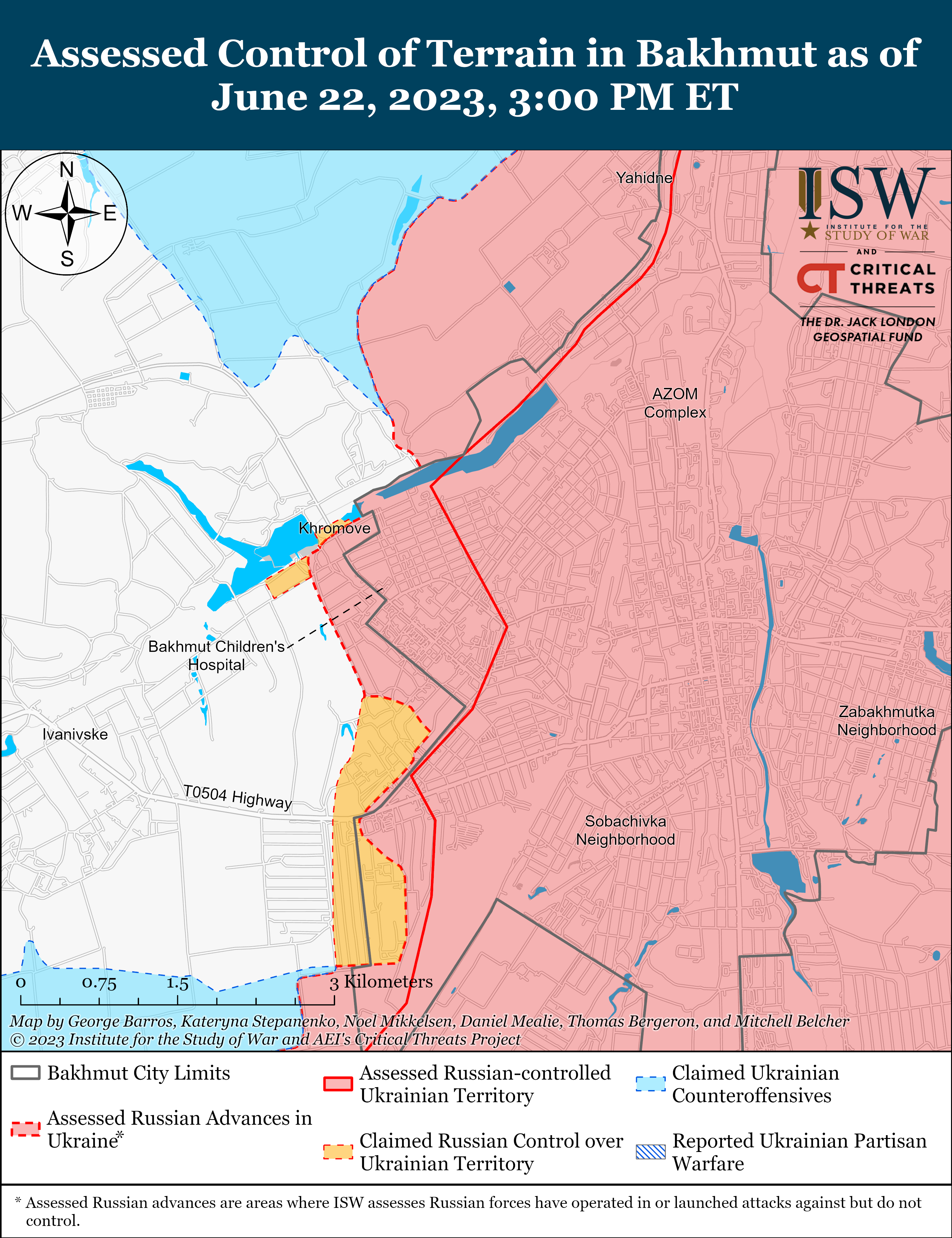
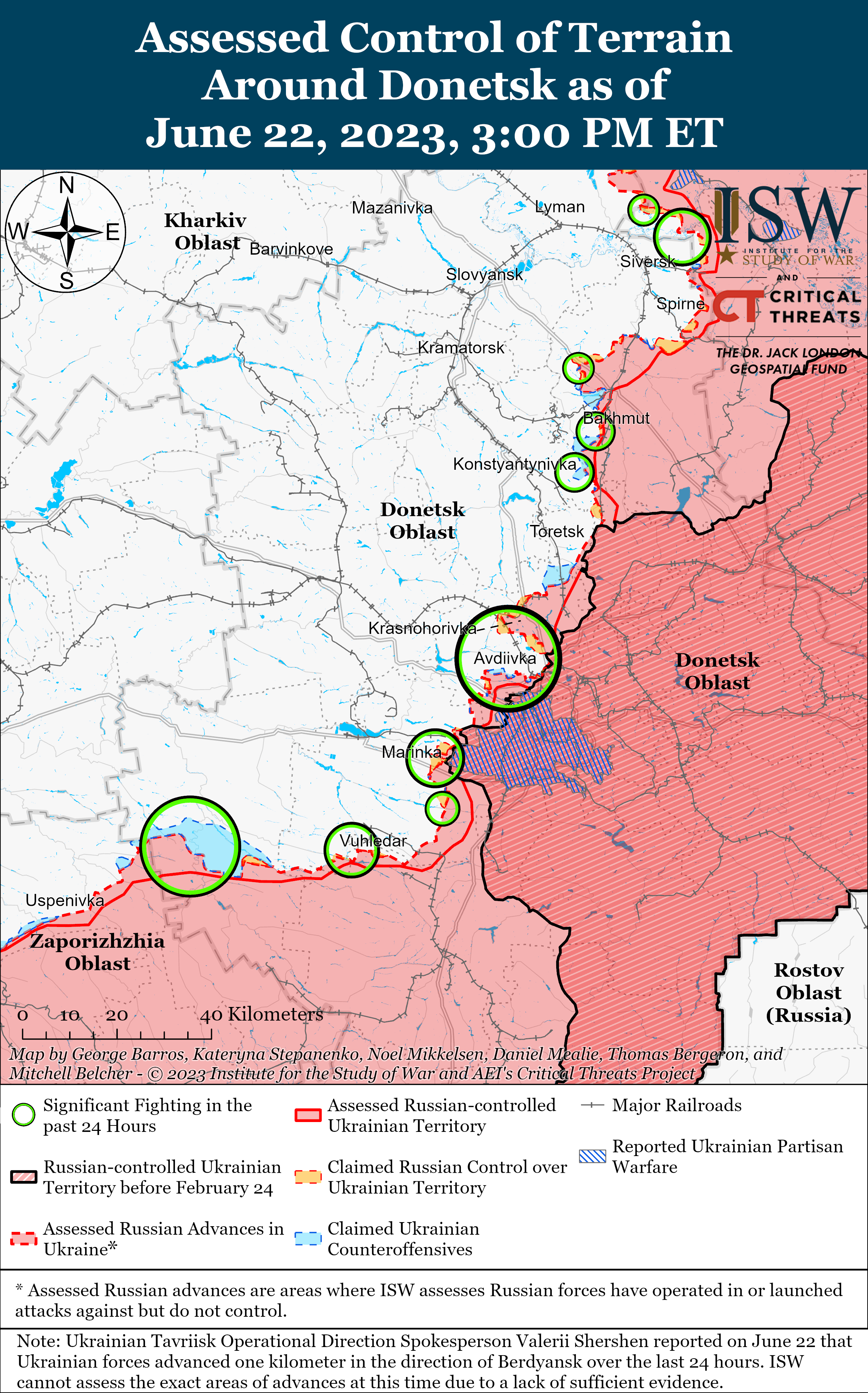
Russian forces conducted limited ground attacks near Bakhmut on June 22. Geolocated footage published on June 21 shows that Ukrainian forces recently made limited advances near Ozaryanivka (14km southwest of Bakhmut).[lv] The Ukrainian General Staff reported that Russian forces conducted unsuccessful offensive operations near Ivanivske (6km west of Bakhmut), Orikhovo-Vasylivka (11km northwest of Bakhmut), and Bila Hora (12km southwest of Bakhmut).[lvi] Ukrainian Eastern Group of Forces Spokesperson Colonel Serhiy Cherevaty reported that the intensity of fighting has decreased in the Bakhmut area due to recent Russian force rotations.[lvii] Cherevaty stated that Russian airborne forces (VDV) and motorized rifle elements operate cautiously after seeing the degradation of the Wagner Group during the Battle of Bakhmut. Footage published on June 21 and 22 purportedly shows elements of the 137th Guards VDV Regiment (106th Guards VDV Division, Western Military District) and the “Prizrak” Battalion (a Luhansk People’s Republic formation) operating near Bakhmut.[lviii]
Ukrainian Ground Forces Commander Colonel General Oleksandr Syrskyi published footage showing Ukrainian forces conducting a HIMARS strike in the Bakhmut direction.[lix] Geolocated footage published on June 22 indicates that Ukrainian forces struck Russian forces south of Kodema (13km southeast of Bakhmut).[lx]
Russian and Ukrainian forces conducted limited ground attacks along the Avdiivka-Donetsk City line on June 22. The Ukrainian General Staff reported that Russian forces conducted unsuccessful offensive operations near Avdiivka, Sieverne (6km west of Avdiivka), Pervomaiske (11km southwest of Avdiivka), Marinka (27km southwest of Avdiivka), Pobieda (4km southwest of Marinka), and Novomykhailivka (36km southwest of Avdiivka).[lxi] Ukrainian Tavrisk Group of Forces Spokesperson Captain Valeriy Shershen reported that Russian assaults are the most intense near Avdiivka and Marinka.[lxii] Chechen Republic Head Ramzan Kadyrov claimed that elements of the 20th Guards Motorized Rifle Division (8th Combined Arms Army, Southern Military District) advanced near Novomykhailivka, increasing Chechen “Akhmat” Spetsnaz units’ ability to maneuver in the area.[lxiii] Footage posted on June 22 purportedly shows elements of the 1st Slavic Brigade (1st Donetsk People‘s Republic Army Corps) operating near Sieverne.[lxiv] The Russian Ministry of Defense claimed that Russian forces repelled Ukrainian attacks near Sieverne and Pervomaiske.[lxv]
Russian Supporting Effort – Southern Axis (Russian objective: Maintain frontline positions and secure rear areas against Ukrainian strikes)
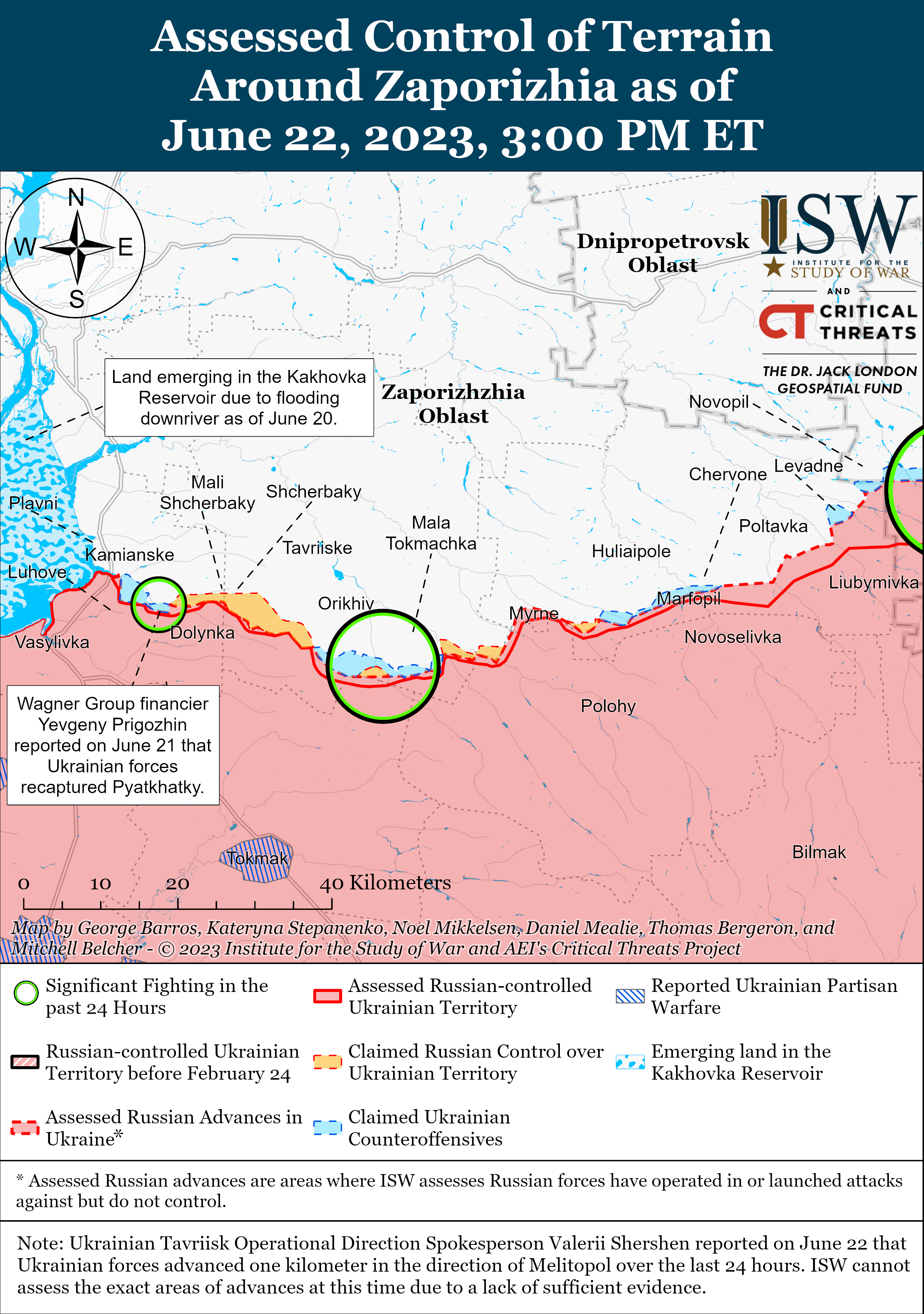
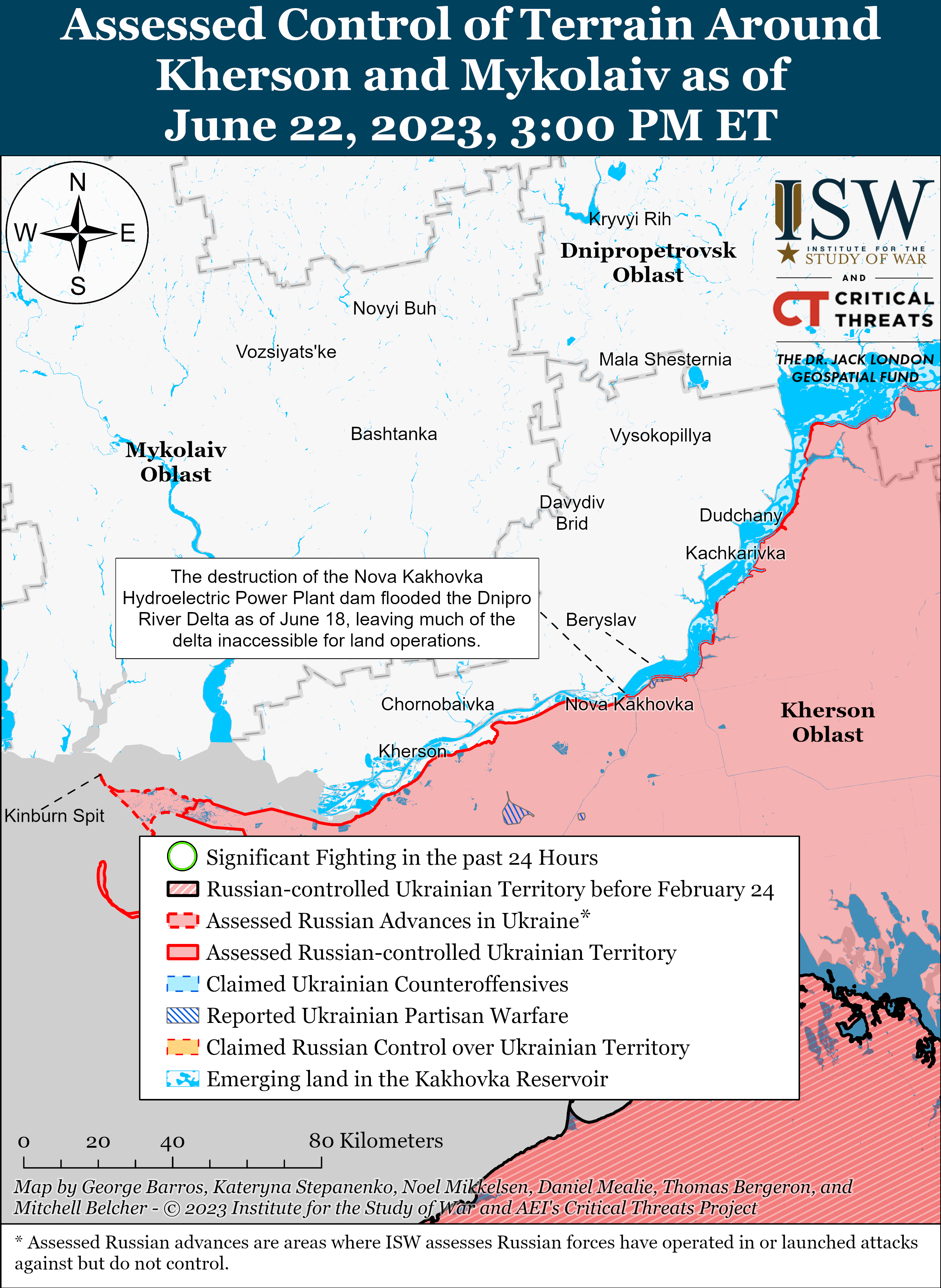
Russian forces conducted a limited ground attack in western Donetsk Oblast on June 22. The Ukrainian General Staff reported that Ukrainian forces repelled a Russian ground attack near Vuhledar (30km southwest of Donetsk City).[lxvi]
Ukrainian and Russian forces continued offensive operations on the administrative border between Donetsk and Zaporizhia oblasts on June 22. Ukrainian Tavrisk Group of Forces Spokesperson Captain Valeriy Shershen indicated that Ukrainian forces advanced up to one kilometer in the Donetsk-Zaporizhia border area and in western Donetsk Oblast.[lxvii] The Ukrainian General Staff reported that Ukrainian forces had partial successes on the Rivnopil-Staromayorske line (up to 8km south of Velyka Novosilka).[lxviii] The Ukrainian General Staff also reported that Russian forces attempted to recapture lost territory near Makarivka (5km south of Velyka Novosilka).[lxix] The Russian Ministry of Defense (MoD) claimed that Russian forces repelled two Ukrainian ground attacks near Novodonetske (11km southeast of Velyka Novosilka) and Makarivka.[lxx] Russian milbloggers claimed that Russian forces also repelled Ukrainian ground attacks near Urozhaine (10km south of Velyka Novosilka).[lxxi]
Ukrainian forces continued counteroffensive operations in western Zaporizhia Oblast on June 22. The Russian MoD and other Russian sources claimed that Russian forces repelled Ukrainian ground attacks on the Novodanylivka-Robotyne line (up to 12km south of Orikhiv).[lxxii] Russian sources claimed that Ukrainian forces attacked near Pyatykhatky (23km southwest of Orikhiv) and that control of the settlement has changed multiple times.[lxxiii] A Russian source claimed that Russian forces control half of Pyatykhatky, and other Russian sources claimed that Ukrainian forces advanced near Zherebyanky immediately southwest of Pyatykhatky.[lxxiv] Another Russian source claimed that Russian forces pushed Ukrainian forces to positions north of Zherebyanky and that Russian forces established positions in nearby areas.[lxxv] The Ukrainian General Staff reported that Russian forces conducted unsuccessful ground attacks in the direction of Pyatykhatky.[lxxvi] Russian sources claimed that Ukrainian forces attacked southeast of Orikhiv near Verbove (19km southeast), and a Russian milblogger claimed that Ukrainian forces made marginal advances near Novofedorivka (18km southeast).[lxxvii] A Russian source claimed that Russian forces repelled a Ukrainian sabotage and reconnaissance group near Dorozhnyanka (6km south of Hulyaipole).[lxxviii]
A Russian milblogger claimed on June 22 that Ukrainian forces attempted a limited raid against islands in the Dnipro River delta southwest of Kherson City.[lxxix] The source claimed that Russian forces repelled a Ukrainian sabotage and reconnaissance group near Hola Prystan (9km south of Kherson City). Other Russian milbloggers claimed on June 21 that Ukrainian forces did not attempt to land near Hola Prystan.[lxxx] The milbloggers also claimed that the Russian 80th Separate Motorized Rifle Brigade (14th Army Corps, Northern Fleet) is defending near Hola Prystan.
The Russian Navy is reportedly attempting to camouflage some of its missile carrying warships against possible Ukrainian strikes. Naval News reported on June 22 that Russian forces applied a new camouflage to the Admiral Essen Admiral Grigorovich-class frigate, which is capable of carrying up to eight Kaliber cruise missiles, to hide the vessel from Ukrainian drone operators.[lxxxi] It is unclear how successful this camouflage is at hiding the vessel from Ukrainian strikes, however.
Russian Mobilization and Force Generation Efforts (Russian objective: Expand combat power without conducting general mobilization)
Ukrainian officials reported that Russian forces are transferring GRU Spetsnaz units to Kursk and Bryansk oblasts to fight Russian partisans. The Ukrainian Resistance Center reported on June 22 that Russian forces transferred 50 GRU servicemen to Tyotkino, Kursk Oblast and Suzemivka, Bryansk Oblast.[lxxxii] The Resistance Center also reported that Russian Special Operations Forces (SSO) and the GRU are competing for responsibility in border regions.[lxxxiii] Elements of the Chechen “Zapad Akhmat” Special Forces Battalion recently arrived at the Nekhoteevka and Kozinka border checkpoints in Belgorod Oblast to defend against limited border raids by all-Russian pro-Ukrainian groups.[lxxxiv] These Chechen elements reportedly occupy rear defensive positions in the area, and regular Russian formations in the area reportedly view these Chechen deployments as public relations measures for Chechen Republic Head Ramzan Kadyrov.[lxxxv] Russian special forces formations may be competing for involvement in border protection operations in an effort to avoid deployment to more attritional frontal lines in Ukraine and preserve their forces.
Russian Deputy Defense Minister Colonel General Aleksandr Fomin stated that four Russian volunteer formations signed contracts with the MoD on June 22, namely the “Chechen Republic” Battalion, the “Alexander Nevsky” Detachment, the “Kutuzov” Brigade, and the “Suvorov” Division.[lxxxvi] These volunteer formations will reportedly operate under a unified command of Russian Special Operations Forces (SSO), according to the new contracts.[lxxxvii]
The Wagner Group is reportedly recruiting former Russian law enforcement personnel to form Wagner military police units in occupied Ukrainian territories. Russian opposition outlet Verstka reported that a Wagner recruiter claimed that Wagner military police units will have the authority to detain Russian volunteer and regular formation service members.[lxxxviii]
Russian state space corporation Roscosmos continues efforts to recruit personnel for the “Uran” volunteer battalion. The Financial Times reported on June 20 that Roscosmos and other state-owned subsidiaries in the aerospace sector are recruiting their employees to join the “Uran” battalion.[lxxxix] The Financial Times noted that Roscosmos’ lack of public acknowledgement of the effort is likely aimed at preventing any further western sanctions against the company. ISW previously assessed the possible recruitment of highly educated and likely limited specialists in the Russian aerospace field suggests that Russian officials may be prioritizing immediate force-generation requirements over long-term human capital needs.[xc]
Activities in Russian-occupied areas (Russian objective: Consolidate administrative control of annexed areas; forcibly integrate Ukrainian civilians into Russian sociocultural, economic, military, and governance systems)
Russian sources claimed that the Russian Federal Security Service (FSB) arrested a group of saboteurs in occupied Melitopol that allegedly planned the assassination of unnamed Zaporizhia Oblast occupation officials and sabotage against railroads.[xci]
Russian federal subjects continue to assume patronage over select districts throughout occupied Ukraine. Zaporizhia Oblast Occupation Head Yevgeny Balitsky met with Penza Oblast Governor Oleg Melnichenko on June 22 to discuss the restoration of infrastructure facilities in Polohy and Tokmak raions in occupied Zaporizhia Oblast under the patronage of the Penza Oblast administration.[xcii]
A Russian independent outlet claimed that Russian businessmen affiliated with Chechen leader Ramzan Kadyrov and Russian deputy theater commander in Ukraine Army General Sergei Surovikin are profiting by looting the remains of Mariupol factories. The outlet claimed that Russian businessmen exported at least $1.5 million worth of sheet steel, coal, raw material, and other Ukrainian property from warehouses in Mariupol.[xciii]
Significant activity in Belarus (Russian efforts to increase its military presence in Belarus and further integrate Belarus into Russian-favorable frameworks).
ISW will continue to report daily observed Russian and Belarusian military activity in Belarus, as part of ongoing Kremlin efforts to increase their control over Belarus and other Russian actions in Belarus.
A Belarusian independent outlet reported on June 22 that a likely Russian Mi-24 helicopter crashed in Baranovichi Raion, Brest Oblast.[xciv] The Belarusian Ministry of Defense claimed that a Mi-24 helicopter of unspecified ownership made a “hard landing” in Baranovichi Raion, however.[xcv]
Satellite imagery obtained on June 19 indicates that unknown construction work is ongoing on the northeastern part of the 1405th Artillery Ammunition Base near Osipovichy, Belarus since March–April 2023.[xcvi]
View Citations